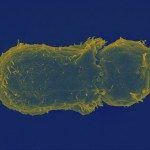Link to Pubmed [PMID] – 7759540
J. Biol. Chem. 1995 May;270(21):12839-45
Superantigens are able to stimulate T lymphocyte populations expressing T cell antigen receptors (TCR) belonging to particular V beta families. Moreover, the presence of these superantigens may induce long term unresponsiveness (anergy) of these sensitive cells. Some bacterial toxins are potent superantigens. We have analyzed in vitro the capacity of some Staphylococcus aureus enterotoxin superantigens to modulate T cell antigen receptor expression and the cellular mechanisms involved. Staphylococcus enterotoxin B (SEB) induced rapid down-regulation of surface T cell antigen receptors in V beta 3-expressing T lymphocytes, as assessed by flow cytometry. This phenomenon was a consequence of the direct interaction between the toxin and the TCR since it was observed in the absence of cells expressing major histocompatibility complex class II molecules. The cellular mechanism involved in SEB-induced down-regulation of TCR was further investigated. Immunofluorescence and confocal microscopy experiments showed that toxin B induced intracellular accumulation of TCR.CD3 in endocytic vesicles. Moreover, SEB induced an increase in T cell receptor endocytosis as measured using radiolabeled Fab fragments of an anti-CD3 monoclonal antibody. Taken together, our observations indicate that Staphylococcus enterotoxin B superantigen induced changes in the dynamics of surface T cell receptors, which resulted in the fast reduction of membrane receptor numbers.

